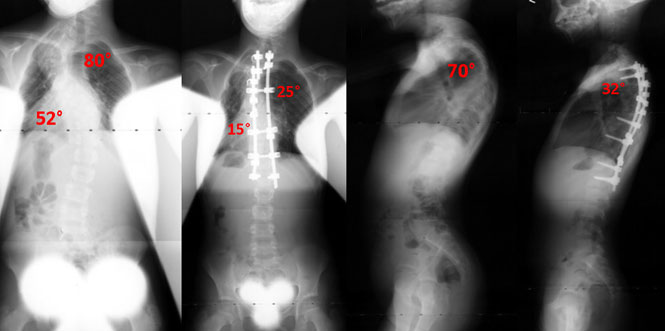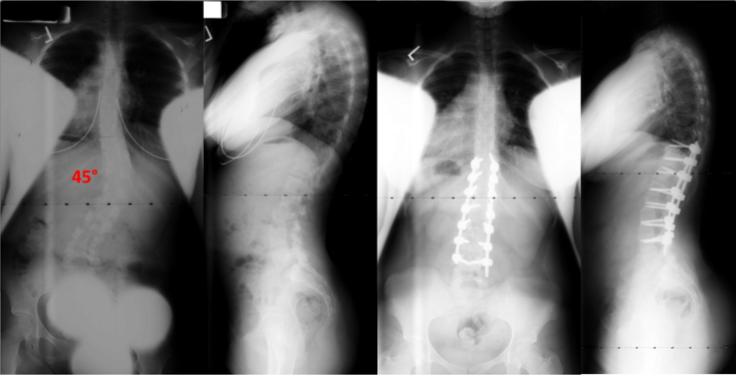Neurofibromatosis
Neurofibromatosis is one of several genetic disorders (neurofibromatosis types I, II, and III) that greatly increase a person’s risk of developing growths or benign neoplasms comprised of nerve tissue, the so-called neurofibroma. Neurofibromatosis is an autosomal dominant disorder, meaning that it is always expressed in individuals who have the gene. Parents with one copy of the gene have a 50% chance of passing the gene on to their children. On the other hand, neurofibromatosis can also occur due to spontaneous mutation with no family history.
Types of neurofibromatosis
Neurofibromatosis type I, the most common type, causes tumors that develop along the nervous system. Type II causes tumors to grow in the part of the brain that carries auditory (hearing) information, resulting in hearing loss. It can also cause tumors along the spine in about half of patients, and it is associated with lesions of the eye, Lisch nodules. Type III, also called schwannomatosis, is the rarest form of neurofibromatosis.
Symptoms of neurofibromatosis type I
Neurofibromatosis type I is most notable by the dark brown spots it causes on the skin, called cafe au lait spots. The disease is also apparent from soft, fleshy, benign tumors called neurofibromas that develop on or under the skin. Neurofibromas occurring on the skin often resemble skin tags. Almost all people with neurofibromatosis develop very small growths on the irises of the eye called Lisch nodules. Lisch nodules do not affect vision.
Most neurofibromas affect the peripheral nervous system, meaning they grow along peripheral nerves rather than the spine or brain. These tumors become more prevalent with age. People with neurofibromatosis are also more likely to develop malignant tumors. The overall risk of malignant tumors in patients under 50 years of age is approximately 2.5 to 4 times higher than in the general population.
Neurofibromatosis type I may cause learning disabilities and epilepsy. While Lisch nodules do not affect vision, vision problems can be caused by tumors that develop around the optic nerves and visual system.
The effects of neurofibromatosis on bone and spine
In infants and children, neurofibromatosis type I can interfere with the development of the spine. The disease can affect the protective covering of the spine, called the dura. Increased pressure in the spinal fluid due to neurofibromas of the spinal nerves can result in dural ectasia, which is a ballooning out of a sac that contains the cerebrospinal fluid. This condition may result in pain in the back and limbs, bladder control problems, and numbness in severe cases.
Neurofibromatosis may cause tumors on an around the spinal cord. Even benign tumors in this area can cause pain and weakness in the most severe cases.
Scoliosis, an irregular side curvature of the spine from left to right, and kyphosis, or a rounded or forward angulated back, occur together or separately in about one in five people with neurofibromatosis type I.
Osteoporosis is common among neurofibromatosis type I sufferers, who generally have lower bone density by age than healthy individuals.
While physical therapy may be able to relieve minor structural problems with the spine, definitive treatment often requires orthopedic surgery. Orthopedic spine surgery, can correct these conditions and restore quality of life to the patient with neurofibromatosis.
Scoliosis and neurofibromatosis
Children with neurofibromatosis type I develop one of two forms of scoliosis, dystrophic or non- dystrophic scoliosis. Non-dystrophic scoliosis, even in children with neurofibromatosis, is quite similar to “typical” scoliosis, called adolescent idiopathic scoliosis.
Dystrophic scoliosis, on the other hand, is a form of scoliosis that occurs due to bony changes related to neurofibromas affecting the spine. Dystrophic scoliosis is identified by looking for specific features on X-rays of the spine. For patients and their families, dystrophic scoliosis is known as a more severe form of scoliosis. It may also occur with abnormally thin ribs, weakened vertebral bones, and severe spinal curvatures including kyphosis and rotational deformities and is often associated with dural ectasia.
Treatment for scoliosis due to neurofibromatosis is challenging, particularly when dystrophic scoliosis is present. Effective treatment requires the knowledge and skill of an experienced orthopedic surgeon who specializes in scoliosis treatment.
Patient Story 1
This is a 15 year old young lady with neurofibromatosis involving her spine and causing severe scoliosis requiring corrective surgery. She has done very well following her operation which was over ten years ago.

Patient Story 2
This 13 year-old girl has scoliosis associated with neurofibromatosis. Her curvature progressed significantly over a short period of time. Dr. Lonner performed corrective surgery which resulted in almost 100% correction of her curve.

